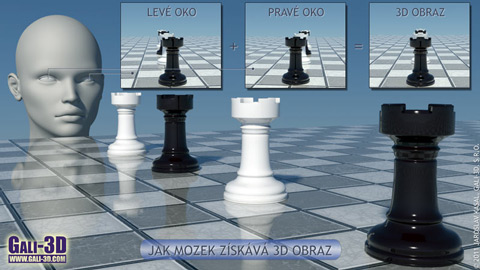The Principles of 3D Stereoscopic Technologies

How 3D stereoscopy works?
To be able to see in 3D (to have a feeling of depth) we need two eyes. We see the picture twice and from the horizontal shift we can extract the depth information. The human brain is able to analyze the differences between these two images and extract the information about the distance to the objects in the picture.
3D stereoscopic recording
To be able to record stereoscopically we need to use 2 synchronize recording devices (video cameras or photo cameras). During the scene recording it is necessary to simulate the work of the two human eyes. In reality the problematic is much more complex – the camera separation is determined by the scene analysis and it is necessary to consider the 3D scene characteristic during post-processing. A strong simplification – we need to record the scene in the same way how the two human eye works.
3D stereoscopic visualization
To be able to show an image in 3D we need to deliver to each human eye the corresponding image form the left or right camera. It sound simple, but it is a relatively complex problem. There exist several systems for visualization of 3D stereoscopic data but all of them solve in principle the same task – to deliver 2 different scene view. The list of the most widespread systems follows: 3D active system, 3D passive projection, hybrid active passive-system - 3D Polarization Modulator, auto-stereoscopic monitors and the old red-blue glasses based anaglyph. All of these systems have specific advantages and disadvantages.
Overview of 3D stereoscopic technologies:
| technology | color informations | rozlišení obrazu | projection | monitors / tv | num. of viewers | 3D cinema expenses [price / operating costs] |
| Active 3D | full | high | yes (2) | yes (3) | limited (4) | high / high |
| Passive 3D | full | high | yes | yes | high | high / low (5) |
| 3D Polarization Modulator | full | high | yes | no | high | middle / low |
| 3D Auto-Stereoscopic Monitors | full (1) | low | no | yes | low | - |
| 3D Anaglyph | very bad | middle | yes | yes | high | low / low |
(2) - active 3D is not suitable for large 3D cinemas. Active 3D glasses are expensive and servising is also hard job (repairing, changing/recharging bateries).
(3) - active 3D displays (3D TV, computer 3D flat panels) provide the highest 3D quality from all 3D screens.
(4) - number of viewers is limited by expensive 3D glasses and the wireless signal range.
(5) - 3D Modulator is currently the best 3D technology for all modern 3D digital cinemas.

